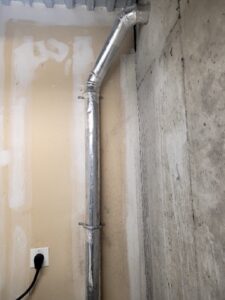
Over the past year, we have responded to numerous jobs in which the dryer vent needed to be “re-piped”. Often times, the homeowner is unaware there is a problem, thus when we suggest that the vent be replaced we are usually met with uncertainty. Below I will explain what we look for when making the determination to recommend replacing your vent:
Material: Dryer vents should be composed of flexible aluminum, semi-rigid aluminum, or hard metal piping. These are the appropriate materials designed to exhaust heat and moisture. In the past, we have seen vents made of vinyl, PVC, and leftover HVAC venting. These materials are NOT designed for dryer venting use and can have adverse effects to the machines operation and overall safety.
Length: When mentioning the optimal materials for dryer vent composition there are several things to consider. First, the flexible aluminum venting is supposed to be used as “transitional ductwork”. This means that the material should run from the dryer to the more rigid material. It should only be run 8 feet, maximum. Often times we see this material used for the full length of the dryer vent. Over time this material will degrade, sag, and/or rip. For these reasons, when we encounter this type of venting, we recommend replacing it with hard metal piping.
Home Age: Often times, when we make our discoveries, the homeowner will ask us why this was not done during initial construction or remodeling. The answer to this question varies. For older homes, the ducting codes were different in the 1960s-1980s. Furthermore, dryers are a relatively new technology. When they were installed, in older homes, builders were not aware how poor venting methods/materials would affect the machine and potentially lead to mold or fires in the future.
If you believe you have an inferior vent and want to have it changed, give us a call for a free quote: 860-414-4206. I usually ask for some information, via phone, to gauge the extent of the project. For pricing, I find the winter months to afford the consumer the best options. Working in basements and cool attics is best in Winter months and these factors affect our pricing.